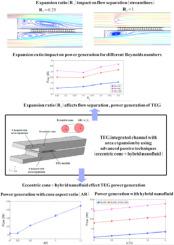当前位置:
X-MOL 学术
›
Int. J. Mech. Sci.
›
论文详情
Our official English website, www.x-mol.net, welcomes your
feedback! (Note: you will need to create a separate account there.)
Performance of TEG integrated channel with area expansion by using advanced passive techniques
International Journal of Mechanical Sciences ( IF 7.1 ) Pub Date : 2021-03-01 , DOI: 10.1016/j.ijmecsci.2020.106210 Fatih Selimefendigil , Hakan F. Öztop
International Journal of Mechanical Sciences ( IF 7.1 ) Pub Date : 2021-03-01 , DOI: 10.1016/j.ijmecsci.2020.106210 Fatih Selimefendigil , Hakan F. Öztop

|
Abstract In this study, flow separation effects on the power generation and conversion efficiency of a thermoelectric generator integrated channel flow with area expansion are numerically studied. Impacts of using an eccentric conic object near the thermoelectric device on the performance enhancement of the system are explored with numerical simulation using finite element method. Hybrid nano sized particles are also included in the heat transfer fluid to improve thermal transport features of the base fluid. Impacts of Reynolds number (between 200 and 1000), expansion ratio of the channel (between 0.25 and 0.6), aspect ratio (between 0.1 and 1.5), location (between -1 and 5) and size (between 0.05 and 0.25) of the eccentric cone and solid nanoparticle volume fraction (between 0 and 0.02) on the fluid flow and generated power characteristic are numerically studied. It is observed that the vortex behind the step extends over the thermoelectric device surface at the highest Reynolds number while vortcies are also established behind the eccentric cone. When the expansion ratio is increased, thermo electric device power reduction is observed while the amounts are 34 % and17.8 % for cases at R 1 =0.25 with Reynolds number of 200 and 1000 as compared to upper channel with R 1 =0.6. The conversion efficiency also rises with higher expansion ratio while the pressure coefficient has its lowest values at R 1 =0.4.When the cone aspect ratio, size and its horizontal location from the step are increased, resizing of the vortex behind the upper channel step is observed while more fluid deflection toward the thermoelectric device is obtained. Therefore, the power of the device is increased and the power enhancement is in the range of 10 % -12 % for varying size and aspect ratio of the cone while it is up to 20 % for different horizontal locations of the cone. There is significant enhancement in the pressure drop with higher size and aspect ratio of the conic object even though the conversion efficiency rise. However, changing the object location is favorable as compared to increasing the size and aspect ratio of the cone on the power generation, conversion efficiency and pressure drop features. The potential in the device power enhancement with nanoparticle inclusion is higher for lower Reynolds number and lower higher expansion ratio while up to 18 % increment of the power is obtained with nanoparticle inclusion at the highest amount. Conversion efficiencies also rise while pressure drop slightly vary with higher solid nanoparticle volume fractions. A predictive model based on artificial neural networks has been developed that estimates the power generated in the thermoelectric device accurately and fast as compared to high fidelity three dimensional computational fluid dynamics simulations.
中文翻译:

使用先进的无源技术实现面积扩展的 TEG 集成通道性能
摘要 在本研究中,数值研究了流体分离对面积膨胀的热电发电机集成通道流的发电和转换效率的影响。使用有限元方法通过数值模拟探讨了在热电装置附近使用偏心圆锥物体对系统性能增强的影响。传热流体中还包括混合纳米尺寸的颗粒以改善基础流体的热传输特性。雷诺数(200 到 1000 之间)、通道膨胀比(0.25 到 0.6 之间)、纵横比(0.1 到 1.5 之间)、位置(-1 到 5 之间)和尺寸(0.05 到 0.25 之间)的影响偏心锥体和固体纳米颗粒的体积分数(在 0 和 0 之间。02) 对流体流动和发电特性进行了数值研究。可以观察到,台阶后面的涡流在最高雷诺数下延伸到热电装置表面上,而在偏心锥后面也建立了涡流。当膨胀比增加时,观察到热电装置功率降低,而在R 1 =0.25、雷诺数为200和1000的情况下,与R 1 =0.6的上通道相比,该量分别为34%和17.8%。转换效率也随着膨胀比的增加而增加,而压力系数在 R 1 = 0.4 处具有最低值。当锥体纵横比、尺寸及其距台阶的水平位置增加时,上通道台阶后面的涡旋的大小调整为观察到更多的流体偏转朝向热电装置。因此,装置的功率增加,对于不同尺寸和长宽比的锥体,功率增强在10%-12%的范围内,而对于锥体的不同水平位置,功率增强高达20%。尽管转换效率提高,但随着圆锥物体尺寸和纵横比的增大,压降也有显着提高。然而,与增加锥体的尺寸和纵横比相比,改变物体位置对发电、转换效率和压降特性是有利的。对于较低的雷诺数和较低的较高膨胀比,使用纳米颗粒夹杂物增强器件功率的潜力更高,而在最高含量的纳米颗粒夹杂物时获得高达 18% 的功率增量。转化效率也会提高,而压降随着固体纳米颗粒体积分数的增加而略有不同。已经开发了基于人工神经网络的预测模型,与高保真三维计算流体动力学模拟相比,该模型可以准确快速地估计热电装置中产生的功率。
更新日期:2021-03-01
中文翻译:

使用先进的无源技术实现面积扩展的 TEG 集成通道性能
摘要 在本研究中,数值研究了流体分离对面积膨胀的热电发电机集成通道流的发电和转换效率的影响。使用有限元方法通过数值模拟探讨了在热电装置附近使用偏心圆锥物体对系统性能增强的影响。传热流体中还包括混合纳米尺寸的颗粒以改善基础流体的热传输特性。雷诺数(200 到 1000 之间)、通道膨胀比(0.25 到 0.6 之间)、纵横比(0.1 到 1.5 之间)、位置(-1 到 5 之间)和尺寸(0.05 到 0.25 之间)的影响偏心锥体和固体纳米颗粒的体积分数(在 0 和 0 之间。02) 对流体流动和发电特性进行了数值研究。可以观察到,台阶后面的涡流在最高雷诺数下延伸到热电装置表面上,而在偏心锥后面也建立了涡流。当膨胀比增加时,观察到热电装置功率降低,而在R 1 =0.25、雷诺数为200和1000的情况下,与R 1 =0.6的上通道相比,该量分别为34%和17.8%。转换效率也随着膨胀比的增加而增加,而压力系数在 R 1 = 0.4 处具有最低值。当锥体纵横比、尺寸及其距台阶的水平位置增加时,上通道台阶后面的涡旋的大小调整为观察到更多的流体偏转朝向热电装置。因此,装置的功率增加,对于不同尺寸和长宽比的锥体,功率增强在10%-12%的范围内,而对于锥体的不同水平位置,功率增强高达20%。尽管转换效率提高,但随着圆锥物体尺寸和纵横比的增大,压降也有显着提高。然而,与增加锥体的尺寸和纵横比相比,改变物体位置对发电、转换效率和压降特性是有利的。对于较低的雷诺数和较低的较高膨胀比,使用纳米颗粒夹杂物增强器件功率的潜力更高,而在最高含量的纳米颗粒夹杂物时获得高达 18% 的功率增量。转化效率也会提高,而压降随着固体纳米颗粒体积分数的增加而略有不同。已经开发了基于人工神经网络的预测模型,与高保真三维计算流体动力学模拟相比,该模型可以准确快速地估计热电装置中产生的功率。











































 京公网安备 11010802027423号
京公网安备 11010802027423号